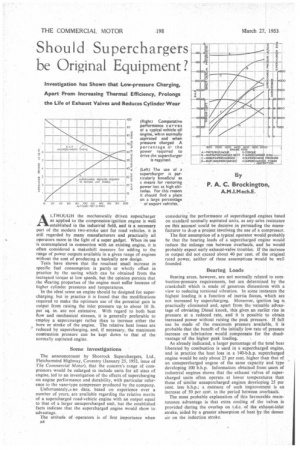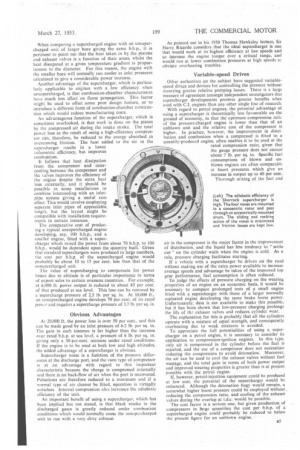Should Superchargers be Original Equipment?
Page 38

Page 39

If you've noticed an error in this article please click here to report it so we can fix it.
Investigation has Shown that Low-pressure Charging, Apart From Increasing Thermal Efficiency, Prolongs the Life of Exhaust Valves and Reduces Cylinder Wear
At,THOUGH the mechanically driven supercharger as applied to the compression-ignition engine is well established in the industrial field, and is a necessary part of the modern two-stroke unit for road vehicles, it is still regarded by many manufacturers and practically all operators more in the light of a super gadget. When its use is contemplated in connection with an existing engine, it is often considered a makeshift measure for adding to the range of power outputs available in a given range of engines without the cost of producing a basically new design. Tests have shown that the resultant small increase in specific fuel consumption is partly or wholly offset in practice by the saving which can be obtained from the• increased torque at low speeds, but the opinion persists that the iglearing properties of the engine must suffer because of higher cylinder pressures and temperatures.
In the ideal sense an engine should be designed for supercharging, but in practice it is found that the modifications required to make the optimum use of the potential gain in output from raising the inlet pressure up to about 10 lb. per sq. in. are not extensive. With regard to both heat flow and mechanical stresses, it is generally preferable to employ a superctiarger rather than to increase either the bore or stroke of the engine. The relative heat losses are reduced by supercharging, and, if necessary, the maximum combustion pressure can be kept down to that of the normally aspirated engine.
Some Investigations
The announcement by Shorrock Superchargers, Ltd., Fletchamsted Highway, Coventry (January 25, 1952, issue of The Commercial Motor), that the concern's range of compressors would be enlarged to include units for all sizes of engine, led to an investigation of the effects of supercharging on engine performance and durability, with particular reference to the vane-type compressor produced by the company. Unfortunately,ano data, based on experience over a number of years, are available regarding the relative merits of a supercharged road-vehicle engine with an output equal to that of a larger unsupercharged unit, but the established . facts indicate that the supercharged .engine would show to
advantage. • The attitude of operators is of first importance when 84 considering the performance of supercharged engines based on standard normally aspirated units, as any sales resistance on this account could be decisive in persuading the manufacturer to chop a project involving the use of a compressor.
The first assumption of a typical operator would probably be that the bearing loads of a supercharged engine would reduce the mileage run between overhauls, and he would probably expect early exhaust-valve troubles. If the increase in output did not exceed about 40 per cent. of the original rated power, neither of these assumptions would be well founded
Bearing Loads
Bearing areas, however, are not normally related to combustion-pressure requirements, but are determined by the crankshaft which is made of generous dimensions with a view to reducing torsional vibration. In some instances the highest loading is a function of inertia forces, which are not increased by supercharging. Moreover, ignition lag is practically eliminated and, apart from the valuable advantage of obviating Diesel knock, this gives an earlier rise in pressure at a reduced rate, and it is possible to obtain increased power without raising the peak pressure. if full use be made of the maximum pressure available, it is probable that the benefit of the initially low rate of pressure increase on rubrication would compensate for the disadvantage of the higher peak loading.
As already indicated, a larger percentage of the total heat liberated by combustion is used in a supercharged engine, and in practice the heat loss in a 140-b.h.p. supercharged engine would be only about 25 per cent. higher than that of an unsupercharged engine of the same capacity and type developing 100 b.h.p. information obtained from users of industrial engines shows that the exhaust valves of supercharged units often operate at lower temperatures than those of similar unsupercharged engines developing 25 per cent. less b.h.p.; a measure of such improvement is an increase of 50 per cent, in the period between overhauls.
The most probable explanation of this favourable maintenance advantage is that extra cooling of the valves is provided during the overlap on t.d.c. of the exhaust-inlet stroke, aided by a greater absorption of heat toy the denser air on the induction stroke.
When comparing a supercharged engine with an unsupercharged unit of larger bore giving the same b.h.p., it is pertinent to point out that the heat taken in by the pistons and exhaust valves is a function of their areas, whilst the heat dissipated at a given temperature gradient is propor tionate to the diameter. For this reason, the engine with the smaller bore will normally run cooler at inlet pressures calculated to give a considerable power increase.
Another advantage of the supercharger, which is particularly applicable to engines with a low efficiency when unsupercharged, is that combustion-chamber characteristics have much less effect on flame propagation. This factor might be used to offset some poor design feature, or to introduce a different form of combustion-chamber construction which would reduce manufacturing costs.
An advantageous function of the supercharger, which is sometimes overlooked, is that work is done on the piston by the compressed air during the intake stroke. The total power loss as the result of using a high-efficiency compressor can, therefore, be reduced to the energy absorbed in overcoming friction. The heat added to the air in the supercharger results in a lower solumetric efficiency, but improves combustion.
It follows that heat dissipation from the compressor and inter cooling between the compressor and
ihe valves improves the efficiency of the engine despite the extra heat
loss externally, and it should be possible in some installations to combine intereooling with an inletpipe system giving a useful ram effect. This would involve employing separate inlet pipes of appreciable length, but the layout might be compatible with installation requirements in certain instances.
The comparative cost of producing a typical unsupercharged engine developing, say, 100 b.h.p., and a smaller engine, fitted with a super charger which raised the power from about 70 b.h.p. to 100 h.h.p., would be dependent upon the quantity built. Given that standard superchargers were produced in large numbers, the cost per b.h.p. of the supercharged engine would probably be about 10 to 15 per cent, less than that of the unsupercharged unit.
The value of supercharging to compensate for power losses due to altitude is of particular importance in terms of export sales to certain overseas countries. For example, at 6,000 ft. power output is reduced to about 83 per cent. of that produced at sea level. This loss can be restored by
a supercharge pressure of 2.5 lb. per sq. in. At 10,000 ft., an unsupercharged engine develops 70 per, cent, of its rated pow .1and requires a supercharge pressure of 3.7 lb. per sq. in.
Obvious Advantages
At 20,000 ft. the power loss is over 50 per cent., and this can be made good by an inlet pressure of 6.2 lb. per sq. in. The gain in each instance is far higher than the increase over rated b.h.p. at sea level, a pressure of 6 lb. per sq. in. giving only a 30-per-cent. increase under rated conditions. If the engine is to be used at both low and high altitudes, the added advantage of a supercharger is obvious.
Supercharger noise is a fudetion of the pressure differences at the discharge port, and the vane type of compres.sor is at an advantage with regard to this important characteristic because the charge is compressed internally and there is no back-flow of air when the port is uncovered. Pulsations are therefore reduced to a minimum and if a normal type of air cleaner be fitted, operation is virtuglly noiseless. Internal compression alsn increases the adiabatic efficiency of the unit.
An important benefit of using a supercharger, which has been implied but not stated, is that black smoke in the discharged gases is greatly reduced tinder combustion conditions which would normally cause the unsuperchareed unit to run with a very dirty exhaust.
As pointed out in his 1950 Thomas Hawksley lecture, Sir Harry Ricardo considers that the ideal supercharger is one that would work at its highest efficiency at low speeds and so increase the engine torque over a critical range, and would run at lower combustion pressures at high speeds tc obviate overheating troubles.
Variable-speed Drives
Other authorities on the subject have suggested variablespeed drives and devices for controlling the pressure without incurring greater relative pumping losses. There is a large measure of agreement amongst independent investigators thai supercharger developments promise greater benefits when used with C.I. engines than any other single line of research.
With regard to petrol engines, the potential advantage ot using a supercharger is theoretically less favourable on the ground of economy, in that the optimum compression ratie of the pres6ure-charged engine is lower than that of an unblown unit and the relative cost of the compressor is higher. In practice, however, the improvement in distribution and combustion when a compressor is fitted to a quantity-produced engine, often enables it to be used at the rated compression ratio, given that the gauge pressure does not exceed about 7 lb. per sq. in. Specific fuel consumptions of blown and unblown engines are often comparable at boost pressures which give an increase in output up to 40 per cent.
Thorough mixing of the fuel and air in the compressor is the major factor in the improvement of distribution, and the liquid has less tendency to "settle out" on the cylinder wails when the engine is cold. As a rule, pressure charging facilitates starting.
If a vehicle with a supercharger be driven on the road without making use of the extra power available to increase average speeds and advantage be taken of the improved top gear performance, fuel consumption is often reduced.
To judge the effects of pressure charging on the wearing properties of an engine on an economic basis, it would be necessary to compare prolonged tests of a small engine fitted with a supercharger with those of a larger normally aspirated engine developing the same brake horse power. Unfortunately, data is not available to make this possible, hut it has been shown that low-pressure charging prolongs the life of tha exhaust valves and reduces cylinder wear.
The explanation for this is probably that all the cylinders operate with a mixture of equal strength, and consequently overheating due to weak mixtures is avoided.
To appreciate the full potentialities of using a supercharger on a petrol engine, it is necessary to consider its application to compression-ignition engines. In this type, only air is compressed in the cylinder before the fuel is injected, and the use of a compressor does not necessitate reducing the compression to avoid detonation. Moreover, the air can be used to cool the exhaust valves without fuel wastage, and the total gain in terms of both power output and improved wearing properties is greater than is at present possible with the petrol engine.
If, however, petrol-injection equipment could be produced at low cost. the potential of the supercharger would be enhanced. Although the detonation bogy would remain, a somewhat higher boost pressure could be employed without. reducing the compression ratio, and cooling of the exhaust valves during the overlap at t.d.c. would he possible.
The cost factor is a serious one, but given production of compressors in large quantities the cost per b.h.p. of a supercharged engine could probably be reduced to below the present figure for an unblown engine.




















































































